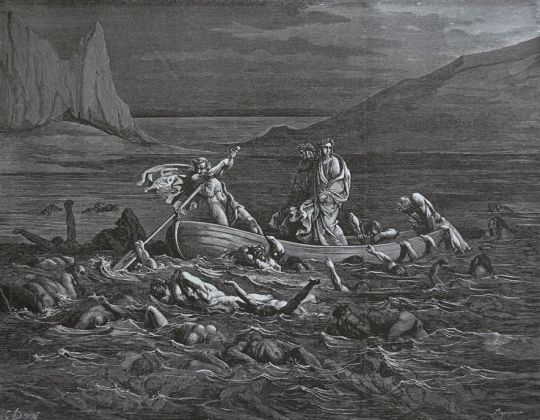Virgil Has Departed, Do Not Weep Yet
(I put together a little academic-ish essay in order to be systematic with my McCarthy habit. I tried to keep it under 2000 words, which means it’s not as thorough as it could be, but it should hold water.)
An Analysis of Cormac McCarthy’s Suttree As It Regards Dante’s Use of Allegory
by Seth Wieck
“I will sing of warfare and a man of war.
I tuned my verse to praise Anchises’ righteous son” (Virgil, emphasis mine).
Please forgive Virgil’s tense change – from simple future to simple past – in the opening lines. The line break denotes 1300 years passing between two of the Mantuan’s songs of Aeneas. Of course, the first line was sung by the historical Virgil in The Aeneid, while Dante voiced the second through his allegorical Virgil. I won’t spend much space explaining that medieval method of exegesis; however, I’ll allow translator Dorothy Sayers to paint some background strokes to my main point: for Dante, “in the allegory, Virgil is the image of Human Wisdom — the best that man can become in his own strength without the especial grace of God…as the image of these things, [he] cannot himself enter Heaven or bring anyone else there” (Introduction. Divine Comedy 67). Bear in mind this lineage of Virgils as we turn our attention to Suttree. I’ll demonstrate, through character and setting, that Cormac McCarthy intentionally places his protagonist Cornelius Suttree in that lineage as a third Virgil, builds an elaborate allegory akin to Dante’s project, and finally McCarthy demolishes the notion of allegory as a legitimate mode of knowledge.
Geography is important for both Dante and McCarthy. For Dante, his geography of Hell is an intricate girder-work to abstract ideas like theology, mythology, and the known cosmos of his time — the nuances of which I’ll leave to the commentaries — but I’ll emphasize: his Hell is effective because the characters of his imagination suffer in real swamps, whirlwinds, winter wastes, and rivers. McCarthy, likewise, takes the topography of a real city, Knoxville, and lays an allegorical map over its contours.

Briefly, I’ll denote the importance of the literal Tennessee River to Suttree, and then explain an allegorical significance it bears to The Inferno’s Virgil. Knoxville is geographically the mouth of the Tennessee River before it cuts across the state and joins the Ohio River, and finally “flows in a sluggard ooze toward southern seas” (McCarthy 4). The character Suttree makes his sometime living as a fisherman on the Tennessee River. The novel opens with Suttree checking his fishing lines. Secondly, Suttree actually resides on the banks of the river in a houseboat, a residence that neither functions fully as a house nor a boat. Similarly in The Inferno, Virgil, Dante’s guide, resides in Limbo, neither fully Hell nor Heaven, on the banks of the River Acheron, the headwaters of all the rivers in Hell. He’s able to cross the river with impunity, fishing out anything he finds living there, in this case Dante himself. And finally, in a pun that reveals McCarthy’s wry sense of humor, we discover that Virgil hangs out with Homer, Horace, Ovid, and Lucan: poets. And what would poets do for all eternity but “check their lines?”

Admittedly, The Divine Comedy has a broad sweep, so the analogy between rivers may seem tenuous at first; however, McCarthy makes further effort to draw the comparison. In one scene, Suttree rises during a foggy dawn. Suddenly another figure in a boat appears out of the gloom, “…already on the river when [Suttree] set forth, standing like some latterday Charon skulling through the fog. With a long pole he hooked condoms aboard and into a pail of soapy water” (107). In Dante, of course, Charon ferries the souls of the damned across the River Acheron into Limbo, crying out, “never you hope to look on Heaven” (Inferno, 3, 85). But even the structure of the description sets the two characters at odds, just as we find Virgil arguing with Charon for the living soul of Dante in Canto 3, so we find these two modern fishermen in competition for the contents of the river: Suttree, who “might even have been a fisher of men in another time” (McCarthy 14) retrieving live things from the detritus, and this “Charon” fishing condoms, a man’s abandonment of hope for future life.
I’ve briefly demonstrated the allegory that McCarthy has constructed between Knoxville and Hell, and between Suttree and Virgil, and this understanding is a valuable hermeneutic for the rest of the book. But to what ends is McCarthy employing the mode of allegory? As Sayers instructs, these allegories are made of “a thing really existing which, by its very nature, stands for and images forth a greater reality” (13). After McCarthy has gone to such lengths to construct an elaborate allegory, similar in scope to Dante, upon a city “really existing,” then it follows that his project is attempting the aim of allegory: to image forth a greater reality. However, McCarthy seems to have realized a modern agnosticism toward anything metaphysical. At one point, Suttree sits outside of a church, listening to the congregation, and “He was stayed in a peace that drained his mind, for even a false adumbration of the world of the spirit is better than none at all” (21). If a greater reality is only a false adumbration, then the aim of allegory falls flaccid. So, again, why does McCarthy employ the allegorical mode?
Early in the novel, Suttree meditates on his own still-born twin brother who is consigned to exist in the “limbo of the Christless righteous” (14). The image of this twin, now a neighbor to Dante’s allegorical Virgil, haunts Suttree throughout the novel, variously arriving as a reflection in a glass door, “His fetch come up from life’s other side… Suttree and Antisuttree, hand reaching to the hand” (28); a dream, “obsession with uniqueness troubled all his dreams. He saw his brother in swaddling, hands outheld, a scent of myrrh and lilies” (113); and in paranoia as Suttree wanders into the woods like a mid-life Dante, “Some doublegoer, some othersuttree eluded him in these woods and he feared that…were he to come to himself in this obscure wood he’d be neither mended nor made whole but rather set mindless to dodder drooling with his ghosty clone” (287). Suttree is haunted by an allegory of himself who might image a greater reality, just as Dante imagined an allegory of the historical Virgil. However, after Suttree nearly dies from typhoid fever, he awakens from a vision of an afterlife and tells a priest, “I learned that there is one Suttree and one Suttree only” (461). The allegorical Suttree has died.

Finally, the novel closes as Knoxville with which we’ve become familiar, and which Suttree used to provide existential meaning, is bulldozed for a modern expressway. “Gnostic workmen” demolish old buildings, leaving “a freestanding stairwell to nowhere” (464); the “concrete of the expressway gleamed…where the ramp curved out into empty air and hung truncate…among the vectors of nowhere” (471). All of these manmade constructions made of literal concrete ultimately point nowhere, and McCarthy, having constructed an elaborate allegory, then demolishes the notion of allegory as a legitimate mode of knowledge, as in: there may be worlds beyond our reckoning, but we can never know.
This agnostic allegory pointing nowhere is actually well represented in Virgil, Dante’s allegory for Human Wisdom, who, as Sayers informed us, could only guide to the border of Purgatory. When Virgil leaves Dante in Canto 30 of The Purgatory, Beatrice must comfort him, saying “Virgil has departed, do not weep yet.” This grief Dante feels for his “sweetest of fathers,” is the same sadness McCarthy’s modern readers experience as we’re left with a secular end-of-things. McCarthy’s project is effective because he leaves us on the shore of Purgatory, gazing across in the mist of unknowing. While Dante constructed an allegorical Virgil, McCarthy’s modern Virgil-in-Suttree stops, turns and "holds his lamp behind him, shedding light not for himself but to make others wise” (Purgatory, 22, 68-69).
*Here’s a proper citation of this essay:
Wieck, Seth. “Virgil Has Departed, Do Not Weep Yet.” Virgil Has Departed, Do Not Weep Yet. 27 Aug. 2015. Web. 27 Aug. 2015. <http://sethwieck.tumblr.com/post/127706531198/virgil-has-departed-do-not-weep-yet>.
Works Cited
McCarthy, Cormac. Suttree. New York: Vintage International, Vintage, 1992. Print.
Sayers, Dorothy L. Introduction. Translation. Divine Comedy. By Dante Alighieri. London: Penguin, 2002. 67, 101, 120. Print.